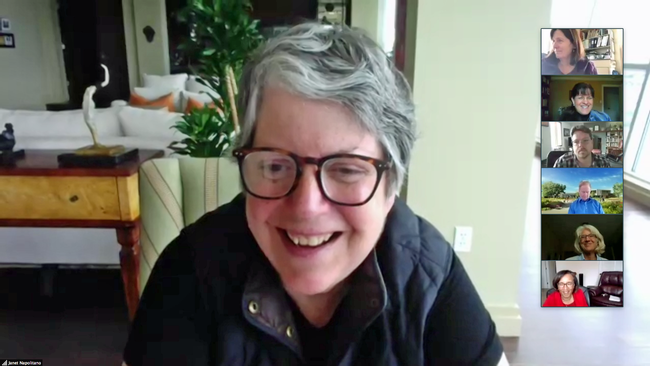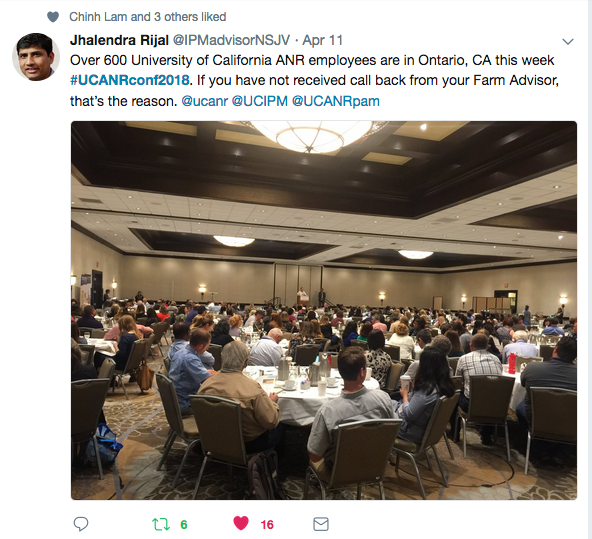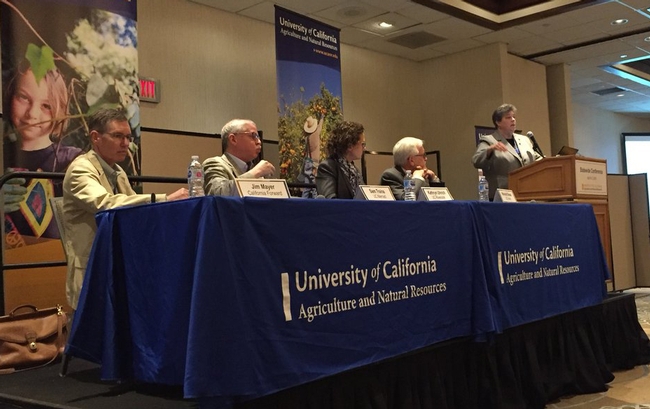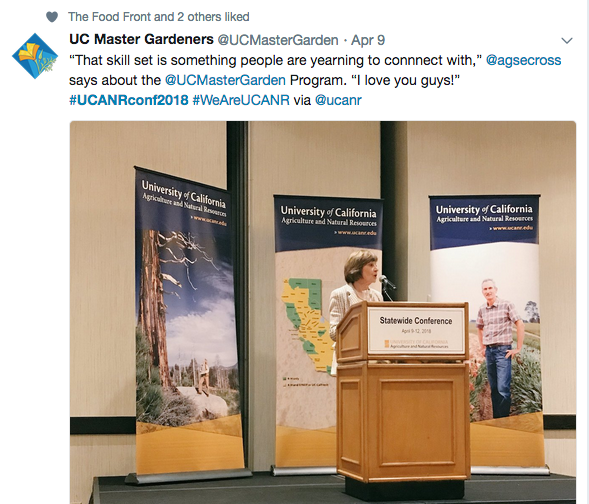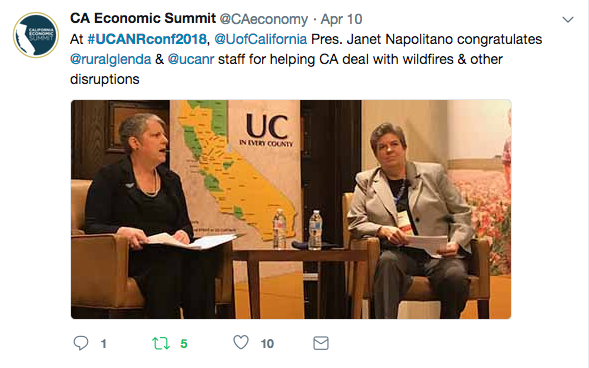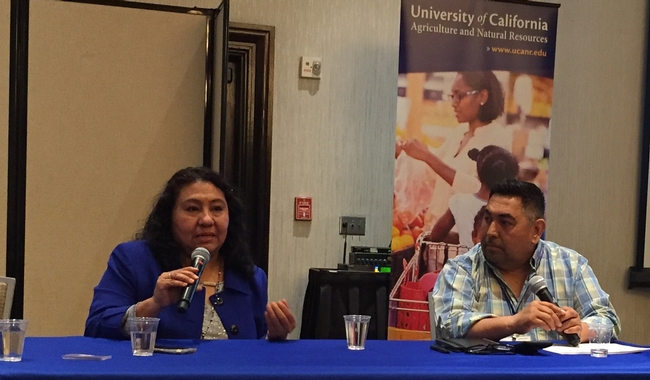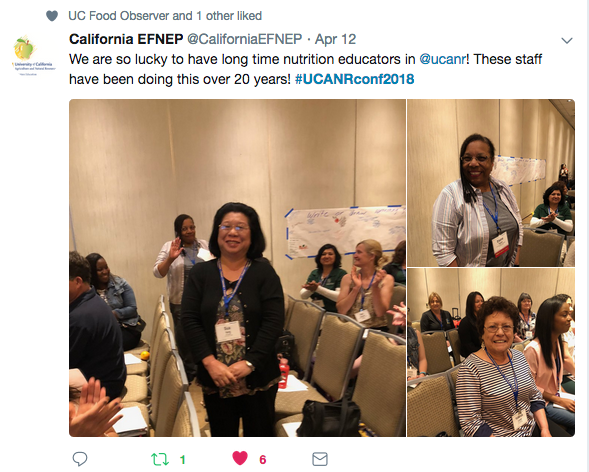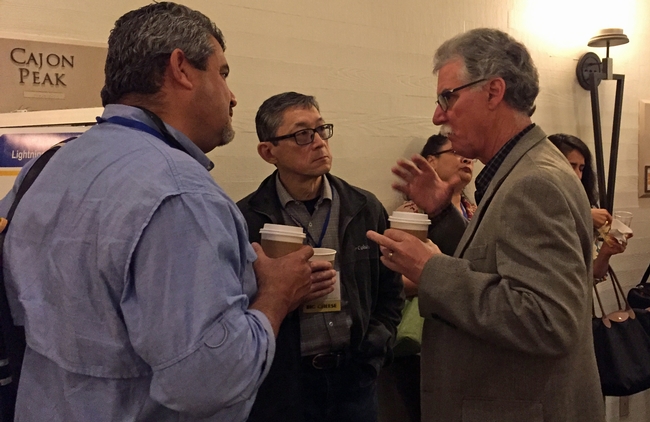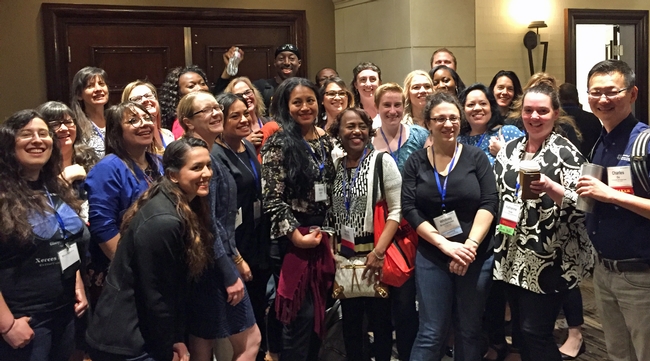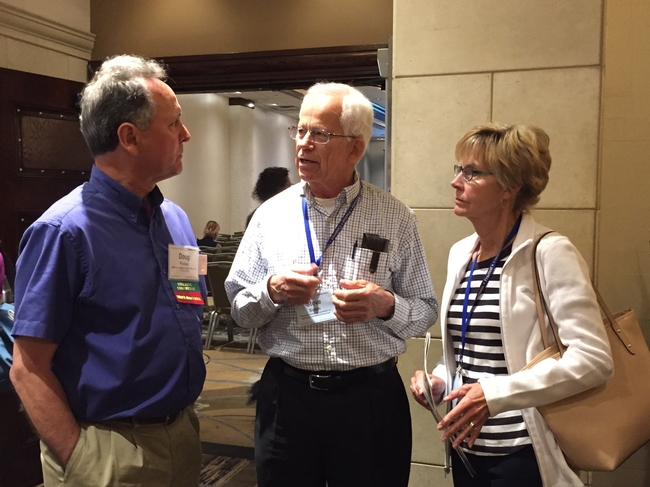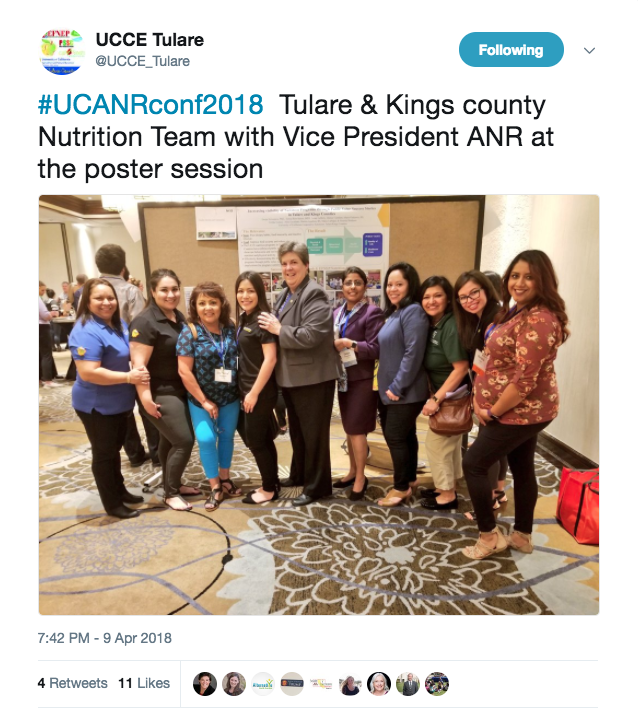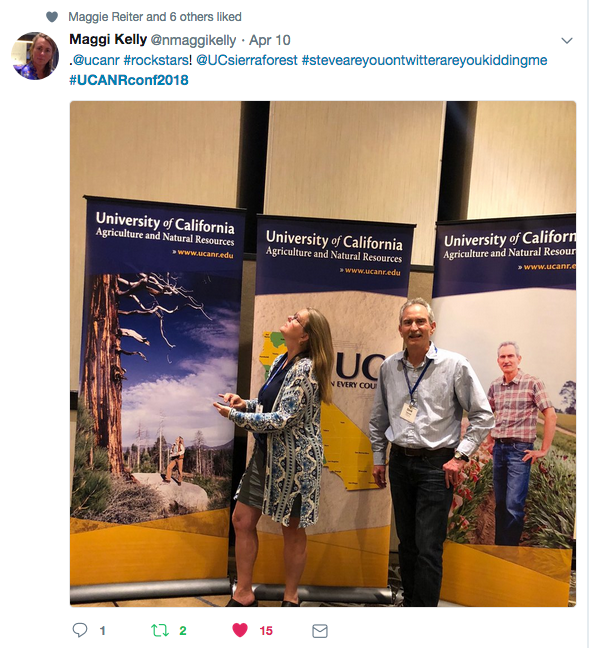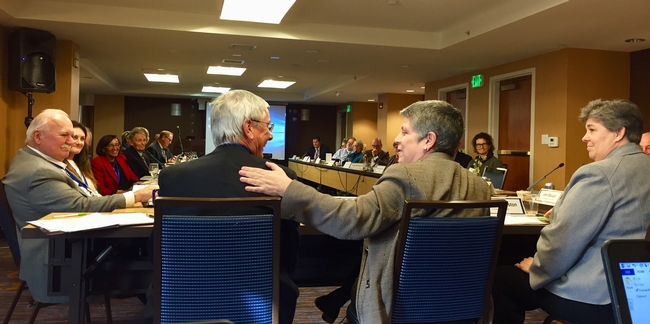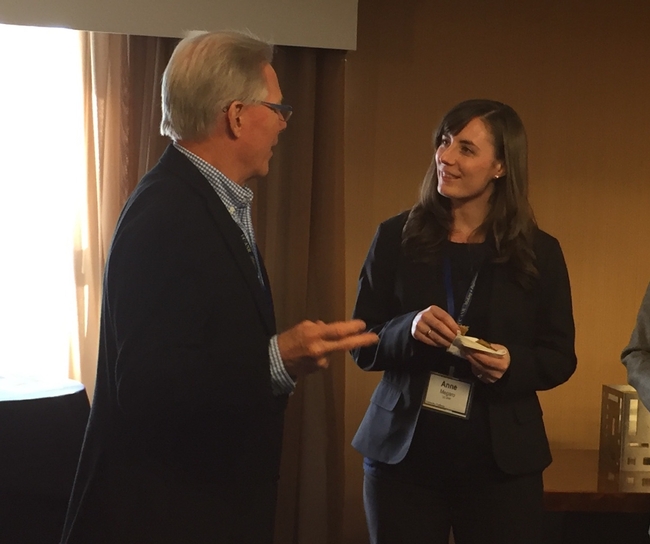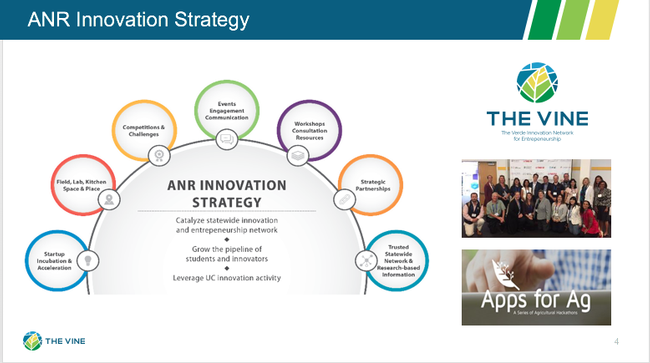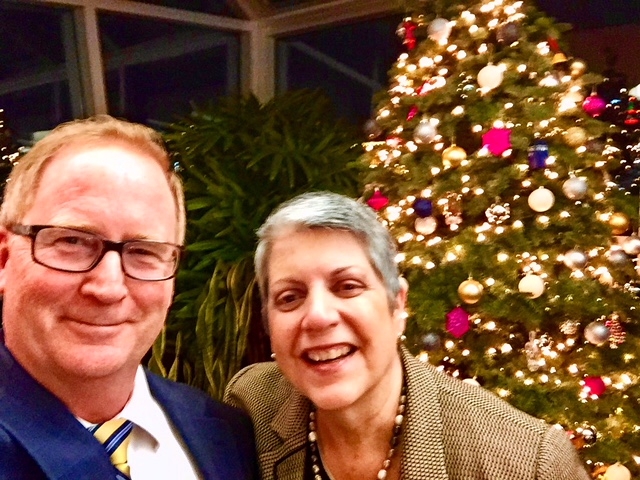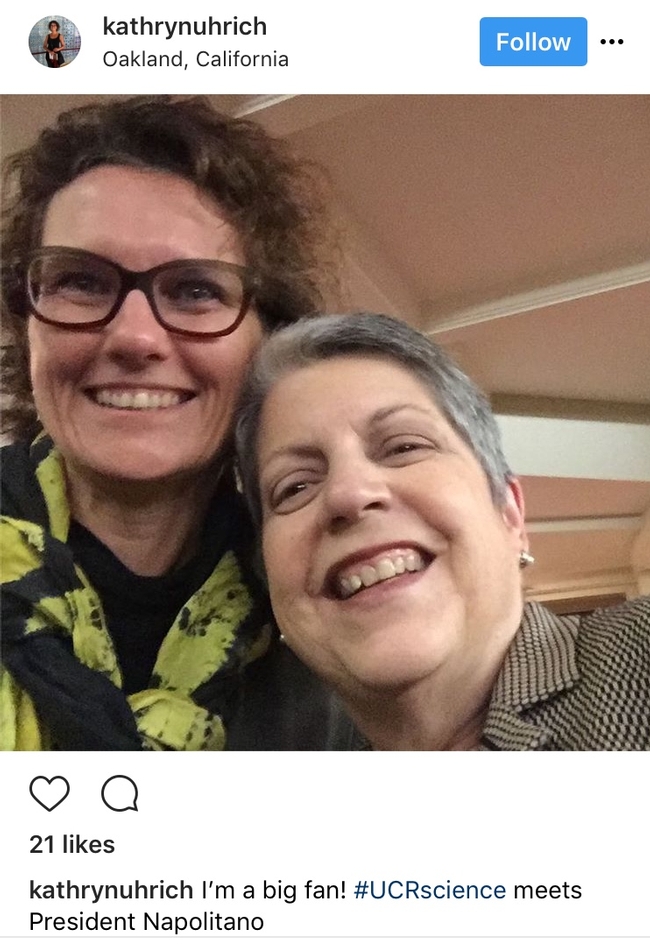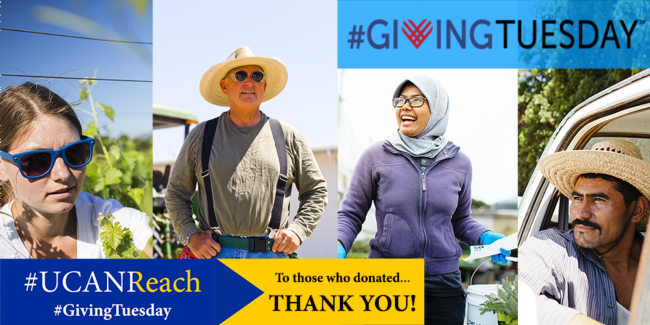Posts Tagged: Janet Napolitano
PAC meets virtually, thanks President Napolitano for her service
The President's Advisory Commission on Agriculture and Natural Resources met via Zoom April 9 as everyone was sheltering in place during the coronavirus pandemic. Jean-Mari Peltier, PAC chair, welcomed the PAC members for their last meeting with President Janet Napolitano. Last September, Napolitano announced that she will step down as UC's leader Aug. 1.
President Napolitano commended ANR for its flexibility in response to the COVID-19 crisis. ANR is “the University of California for large parts of the state and we're proud that you are,” she told VP Glenda Humiston, adding that ANR is performing well under her leadership.
Napolitano thanked the PAC members for contributing their time and advice during her seven years at the UC helm, calling ANR “essential to UC identity as land grant university.” The commissioners thanked the president for her support for ANR. In response to questions about building support for ANR with her successor, Napolitano recommended taking the new president out of Oakland for site visits to learn about ANR. She described her visits to Kearney Agricultural Research and Extension Center, Humboldt County and other ANR sites as “eye opening.”
In her update about ANR, Humiston reported that despite the coronavirus pandemic's disruption to public gatherings, all ANR programs are still serving communities. “I'm really impressed with the innovative ways they are finding to deliver outreach,” she said, adding that advisors are adapting, for example, doing ranch visits via phone. Humiston also described the UC ANR Governing Council's tour of the South Coast Research and Extension Center in February to see how ANR engages urban Californians. She noted that a regents tour of South Coast REC planned for April 23 has been postponed until after the pandemic passes.
Karen Ross, secretary of California Department of Food and Agriculture, joined the group to discuss how CDFA is responding to food system disruption resulting from the COVID-19 crisis. “I am optimistic about agriculture; we are so innovative and resilient,” Ross said, adding that she is concerned about funding for UC ANR and UCCE. She recommended seizing the moment while consumers are thinking about the food system to educate people about UC ANR's role.
Building on their December meeting, the PAC members continued their discussion of the future of the commission. They discussed recommendations to ensure the success and sustainability of ANR as well as the PAC.
They recommended the role of PAC members include
- Communication & advocacy
- Engaging as a strategic tool for problem solving
- Being a connector to industry leaders
- Supporting fund development
- Advising on strategy and mission priorities
To make their membership meaningful, the commissioners said they would like
- Greater active involvement
- Knowing they add value
- Feeling connected with ANR and other PAC members
- Sharing critical information
Although the PAC usually meets twice a year – in the spring and fall – the PAC agreed to meet again via videoconference in May or June to discuss and approve the new PAC charter.
ANR exchanges ideas, creates new collaborations in Ontario
“I don't know about you, but I'm really excited to have this gathering,” VP Glenda Humiston said, as she greeted the people attending the 2018 ANR Statewide Conference in Ontario. More than 650 people participated in the conference held April 9-12 at the DoubleTree by Hilton Hotel Ontario Airport. Humiston noted it was the first time since 2013 that all ANR employees had been invited to meet with their colleagues in person and discuss their work.
There were keynote presentations, science sessions, trainings, program team and workgroup meetings, numerous breakout sessions to attend, puzzles to solve in the resource room, a pop-up studio for News and Information Outreach in Spanish interviews and dozens of research posters to read. ANR leaders discussed how to chart a sustainable future for ANR. Wendell Brase, UC Irvine associate chancellor for sustainability; Sam Traina, UC Merced vice chancellor of research and economic development; and Kathryn Uhrich, UC Riverside dean of the College of Natural and Agricultural Sciences, whose research has spawned start-up companies, discussed opportunities for innovation. Wendy Powers, associate vice president, announced the winners of the Distinguished Service Awards.
And in between, there was time to network with colleagues over meals and in the hallways.
ANR partners also joined the event, including members of the UC President's Advisory Commission on Agriculture and Natural Resources.
Great partnerships
“Think about what California's agriculture would be like without Cooperative Extension,” said California Department of Food and Agriculture Secretary Karen Ross, ex-officio PAC member and keynote speaker for the first day. “It doesn't just happen because of great farmers. It happens because of great partnerships. ANR is in every county.”
“I cannot tell you enough, what an asset you are to this state and to the industry that I love, agriculture, and to every consumer who has the joy of imbibing in our beverages and foods that come from these marvelous lands.”
Unique role in UC
On Tuesday afternoon, UC President Janet Napolitano joined the group. She called out ANR's work in climate change adaptation, agricultural innovation, food systems, food security, and nutrition education and noted the unique role it serves in advancing UC's Global Food, Carbon Neutrality, UC-Mexico initiatives.
She lauded 4-H for achieving parity in Latino youth participation in its programs, saying, “I think that says a lot about ANR's values and the impact it can have.”
Praising UCCE's outreach to economically disadvantaged Californians, the president said, “I'm going to continue to fight hard for funding for these programs at the federal level.”
Napolitano said she was pleased with the overall federal budget, noting that Congress increased funding for the National Institutes for Health and the National Science Foundation. “The University of California gets more NIH and NSF funding than any other university in the country. Almost 10 percent of the NIH research budget comes to the University of California so we have a lot at stake in those federal funds.”
For updates on UC's state and federal budgets, Napolitano urged everyone to sign up at https://www.universityofcalifornia.edu/support-uc/ucan.
On the Huron report recommendations for moving ANR out of the Office of the President's structure, Napolitano said she has appointed a committee to review the options and offer its own recommendations before the November regents meeting.
Building pathways
The crowd was inspired by Antwi Akom, UC San Francisco and San Francisco State University professor and founding director of Social Innovation and Urban Opportunity Lab (SOUL) and co-founder and CEO of Streetwyze. In his presentation “Race, Space, Place and Waste: How Innovation, Education, and Inspiration Can Fearlessly Catalyze California Towards Becoming the World's Leader in Agriculture and Natural Resources Management,” Akom spoke passionately about building more pathways for a more diverse array of Californians to participate in ANR programs.
“That's the first time I've seen members of the audience follow a keynote speaker out of the room,” Mark Bell, vice provost for Strategic Initiatives and Statewide Programs, later commented on the rock star treatment Akom received after his talk.
No layoffs
In her closing comments of the conference, Humiston said, “It was heartwarming to hear so many people tell legislators that ANR programs are important to them,” at the California Farm Bill hearing April 11 in Sacramento. If approved, the bill introduced by Assemblymember Anna Caballero (D-Salinas) would enable ANR to hire 45 more UCCE advisors and would offer incentives to adopt agricultural technology.
Concerning UC's budget challenges, Humiston said ANR is facing reductions in funding that will be absorbed through a slowdown in hiring and other means.
“There will be no layoffs. I took this job to grow ANR not shrink it,” she said emphatically. “The more the people of California understand what ANR does, the more they want us to thrive and be in place to better serve their needs.”
Humiston declared the conference productive and successful and thanked the Strategic Initiative leaders and conference and steering committee for planning the event and the Program Support Unit and volunteers for their hard work.
Doug Parker, Water SI, and Keith Nathaniel, Healthy Families and Communities SI, were the executive co-chairs and David Doll, Sustainable Food Systems; John Harper, Sustainable Natural Ecosystems; and Cheryl Wilen, Endemic and Invasive Pests and Diseases, were co-chairs.
The steering committee was composed of Michael Anderson, College of Natural and Agricultural Sciences, UC Riverside; Mark Bell, Strategic Initiatives and Statewide Programs/Institutes; Sherry Cooper, Program Support Unit; John Fox, Human Resources; Chris Greer, UCCE San Luis Obispo, Santa Barbara and Ventura counties; Brad Hanson, Department of Plant Sciences, UC Davis; Darren Haver, South Coast Research and Extension Center and UCCE Orange County; Mike Janes, Strategic Communications; Maggi Kelly, Informatics and Geographic Information Systems and UC Berkeley; Neil McRoberts, Department of Plant Pathology, UC Davis; Katie Panarella, Nutrition, Family and Consumer Sciences Program and Policy; Maurice Pitesky, School of Veterinary Medicine, UC Davis; Joni Rippee, Program Planning and Evaluation; Rachel Surls, UCCE Los Angeles County; and Patti Wooten-Swanson, UCCE San Diego County.
ANR leadership plans to host the next ANR Statewide Conference in 2021.
Continue the conversations
To see snapshots from the conference on Twitter, search for the hashtag #UCANRconf2018.
If you missed the poster sessions, most of the project posters can be seen by clicking on the title links at http://ucanr.edu/sites/statewideconference2018/Posters_and_Displays.
“I've heard great things about a number of the sessions and have been discussing some follow-up ideas to build on concepts covered during some of those sessions,” Wendy Powers wrote in her ANR Adventures blog. “It would be a disappointment if we all left the meeting, got caught up in our obligations and programs, and didn't continue the conversations.”
President Napolitano analyzes options for ANR in UCOP structure
Dear Colleagues,
In my ANR Update message on Feb. 8, I shared a report released in January by the Huron Consulting Group on the UC Office of the President's (UCOP) organizational structure. President Napolitano's goal in commissioning that review was to improve the effectiveness and efficiency of UCOP, while aligning its work to best support the university's core mission.
As I mentioned last month, Huron offered options that we believe would harm ANR's ability to deliver our mission of research and extension and to bring UC to local communities in every part of California. We identified several issues with both options, chief among those were adding layers of administration between ANR and the UC president as well as between ANR and the public we serve. Those additional layers would likely increase administrative costs and reduce funding for program delivery. At the president's request, we have developed an alternative proposal that would strengthen ANR's ability to deliver our mission while also serving the needs of UCOP for better financial management and administrative efficiency.
A challenge we have faced for years is that about half of our budget flows through UCOP while we manage the remainder directly. ANR is the only major operating division at UCOP that directly conducts research and program delivery, with hundreds of employees throughout California deploying over $200 million in resources. This has caused a great deal of confusion for auditors and often led to budget cuts during calls to reduce UC administrative overhead. Our recommendation places the entire ANR budget into one operating unit/location within the UC Chart of Accounts and allows for more transparency to the public. It also improves ANR's opportunities to stabilize our funding, rebuild our academic footprint and enhance program delivery.
Unlike the institutions used as examples in Huron's report, there is no one flagship campus serving as California's land-grant institution; instead, the entire UC system is responsible for the land-grant mission. To effectively deliver that mission, ANR is structured as a large statewide operating unit administering over 300 Memoranda of Understanding with a wide array of public and private sector partners, including deployment of resources on multiple campuses across the UC system and in close partnership with local governments in every county. The Huron report recognized that housing ANR within one campus was suboptimal and could create perceptions of favoritism and inequities between the campuses. Our proposal calls for a collaborative relationship; injecting competition and administrative layers would not serve the UC system nor our stakeholders well.
Separating ANR's budget and FTE from UCOP offers many advantages to both entities. Under the proposal we have offered, the ANR vice president continues to report directly to the president, the ANR governance structure does not change and no people or infrastructure would be moved. The proposal does agree with the Huron recommendation that ANR funding should be changed to state appropriations and that reconnecting the UC Natural Reserve System to ANR offers improved research opportunities for both entities. We believe these changes would best achieve the president's objectives to better align UCOP support functions to campuses while enhancing the systemwide and statewide functions of a vital outreach and engagement arm of the university.
The president continues to analyze the different options before her to ensure UCOP is best serving the UC system as well as all Californians for the long term. We are excited to work closely with President Napolitano to strengthen UC as a premiere research and extension institute by giving these vital programs room to grow and better serve the critical needs of California's economy and communities. I will continue to keep you apprised as our discussions unfold.
Glenda Humiston
Vice President
PAC discusses innovation and advocacy
Kicking off the meeting by expressing sympathy for everyone affected by wildfires – including the ANR members and Master Gardener volunteers who lost their homes – UC President Janet Napolitano met with the President's Advisory Commission (PAC) at their biannual meeting Dec. 13 at the Courtyard by Marriott in Emeryville.
President Napolitano focused her remarks on the challenges that remain with our food system, saying that she sees endless possibilities for ANR to bring food and ag together with science and technology for agricultural innovation. She also praised ANR for expanding access to its programs and achieving parity in participation of Latino youth in 4-H activities.
Asked about UC's role in production of the state's newly legal crop, Napolitano asked for a report from a systemwide group studying how UC can get involved in cannabis research without running afoul of federal law. VP Chief of Staff Jan Corlett, who represents ANR in that group, offered to relay the PAC's comments at their next meeting.
Napolitano invited the PAC members to join the UC Advocacy Network, or UCAN, to keep informed about state and federal issues that impact the university.
VP Glenda Humiston introduced Anne Megaro, governmental and community relations director. Megaro, who has a Ph.D. in animal science and was the California State Senate Committee on Agriculture's consultant for five years, spoke about her background and discussed how she is working with academics to cultivate relationships with elected officials by sharing stories about their work.
“Every legislator should know ANR because we're in their district,” Megaro said.
“How can I help you talk about ANR?” she asked the PAC members, who responded positively.
Gabe Youtsey, chief innovation officer, described how the Internet of Things, data analysis, robotics, artificial intelligence, drones and plant biotechnology are helping farmers cope with challenges, including workforce shortages, water scarcity and pest pressure. The Apps for Ag hackathons have produced useful tools, but poor rural connectivity is limiting the benefits.
“If we don't solve rural connectivity,” Youtsey warned, “We'll have ag brick instead of ag tech because it won't work.”
He also described the recently launched The VINE, which is designed to catalyze a statewide system to support innovation, entrepreneurship, expand economic opportunities and develop new technology for agriculture, natural resources and rural communities. Youtsey said food and agriculture need “patient capital” investors because venture capitalists desire a fast return on their investment.
Associate Vice President Wendy Powers briefed the commission on ANR's strategic plan. Our “Big Hairy Audacious Goal” is for every Californian to recognize the positive impact ANR has in their lives. The actions will be guided by UCANR's core values: excellence, community, innovation, inclusion, collaboration and integrity. Public value statements are being developed to shape our efforts and “they will give us the elevator speech to articulate who we are and what we do,” Powers said.
Powers also updated the PAC on recent successes, including boosting Giving Tuesday donations by 24 percent over 2016. She announced that 4-H increased its statewide youth enrollment by 18 percent and number of 4-H volunteers by 15 percent and that ANR has completed a salary equity program for staff and advisors and continues to improve internet speeds in county and REC facilities.
In the deans' updates, Keith Gilless announced that in June he will be stepping down as dean of the College of Natural Resources after 11 years to return to his academic work in fire research. Deans Helene Dillard of the College of Agricultural and Environmental Sciences, Kathryn Uhrich of the College of Natural and Agricultural Sciences, Michael Lairmore of the School of Veterinary Medicine and Gilless shared news of awards and large grants received and major projects underway in their respective colleges and school.
In wrapping up the meeting, Humiston announced that Mike Mellano, Dina Moore and Jean Marie Peltier will represent California in Washington D.C. for the CARET (Council on Agriculture Research, Extension and Teaching) meeting in March to advocate for agricultural research and the Farm Bill.
She invited the PAC members to meet next in April in Ontario, in conjunction with the ANR statewide meeting.
UC ANR supporters give over $85,000 on #GivingTuesday
Thanks to everyone who participated, UC ANR's #GivingTuesday campaign was a tremendous success.
“We surpassed our goal of $60,000, raising $85,168,” said Mary Maffly Ciricillo, director of Annual Giving and Individual Gifts. “This is close to a 24 percent increase over last year's Giving Tuesday total of $68,322.”
As an added incentive to potential donors, ANR received over $37,000 in donations toward match challenge funds supporting all of UC ANR programs.
The California 4-H Foundation alone brought in over $32,000. Compared to 2016, there was a 250 percent increase in giving to UC ANR programs – including Master Gardeners, Master Food Preservers, IPM, the REC System, and county offices – totaling over $15,000.
The number of gifts received also rose, from 224 gifts in 2016 to 318 gifts this year. “We even received a gift designated to urban horticulture!” Ciricillo said.
In addition to raising money, the #GivingTuesday social media campaign helped raise the visibility of ANR programs. The Master Gardener Program team made a video of the unselfies posted on social media by their supporters: https://www.youtube.com/watch?v=xI_tVcNhBcQ.
“We appreciate everyone's cooperation in this fundraising effort and hope we can continue to build on our success for the next #GivingTuesday,” Ciricillo said. “These private funds will help us expand UC ANR's reach.”
Below is a list of funds donors selected to receive Giving Tuesday their gifts:
|
ANR - Master Gardener Annual Giving Fund |
|
Alameda County Master Gardener Endowment Fund |
|
Elkus Ranch Fund |
|
San Mateo - 4-H Program - Various Donors |
|
Statewide Master Gardener Endowment Fund |
|
Sacramento County UCCE - Master Gardener Fund |
|
Los Angeles County UCCE Fund |
|
Orange County UCCE Fund |
|
El Dorado County UCCE - Rangeland Fund |
|
San Mateo/San Francisco UCCE - Master Gardener Fund |
|
ANR - Giving Tuesday Match Fund |
|
San Mateo County UCCE - MG Greenhouse |
|
KREC - Kearney REC - Fund |
|
SFREC - Sierra Foothill Research and Extension Center Fund |
|
Sonoma County UCCE - Citizen Science Projects |
|
"urban horticulture" |
|
Los Angeles County UCCE - Master Gardeners |
|
LREC - Lindove Field Station |
|
El Dorado County UCCE - Master Gardeners - Various Dnrs |
|
San Mateo/SF UCCE - Master Food Preserver |
|
Fresno County UCCE |
|
4-H Undesignated |
|
"REC System" |
|
Riverside County UCCE - Master Gardeners |
|
Sutter-Yuba Counties UCCE - Master Gardeners |
|
Merced County UCCE - Master Gardener Fund |
|
UC California Naturalist Program |
|
Ventura County UCCE - Master Gardener Fund |
|
HREC - Hopland REC - Fund |
|
"Marin Master Gardeners Opportunity Fund" |
|
IPM - Program Fund |
|
4-H Foundation UC Donor Funds |
|
DREC - Desert REC FARM SMART Fund |
|
Merced County Agriculture Extension and Research Endowment |
|
Alameda County UCCE - Master Gardeners |
|
UCCE Master Gardeners of Orange County |
|
Orange County UCCE - Master Food Preserver Fund |
|
Kern - 4-H Program - Various Donors |
|
Colusa County UCCE - Master Gardener Program |
|
Central Sierra - UCCE |
|
Ventura County UCCE Fund |
|
"Ventura County Master Gardeners" |
|
San Joaquin County UCCE - Master Gardener Fund |
|
ANR - California Naturalist Scholarship Fund |
|
Statewide Program - Nutrition, Family and Consumer Sciences Program |
|
ANR Informatics and GIS Fund |
|
Nutrition Policy Institute General Fund |
|
Plumas County UCCE - Project Learning Tree |
|
ANR - Master Food Preservers Fund |
|
California Institute for Water Resources |
|
San Mateo County UCCE Fund |
|
Santa Barbara County 4-H - Various Donors |
|
Contra Costa County UCCE Fund |

